The National Archives has a vast and rich collection of designs that were registered with the Board of Trade for copyright protection. They start in 1839 and go up to 1991.
When designers and manufacturers registered a design, they provided their name and address along with a ‘representation’ (photograph, drawing or sample) of the item they were registering. The names and addresses were entered into a large, leather-bound register, and the representations were pasted into even larger bound volumes.
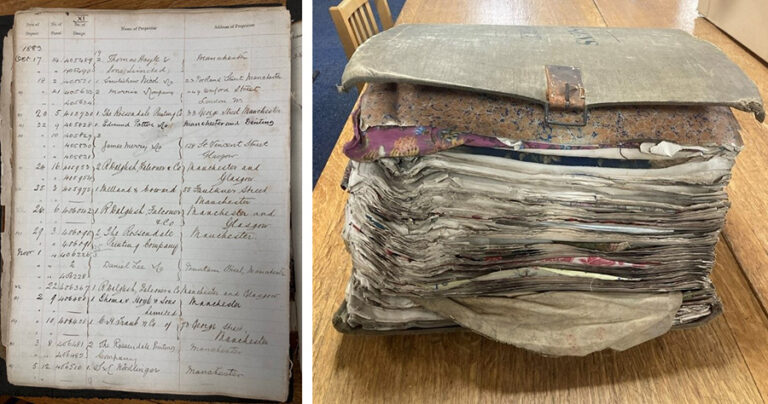
Catalogue descriptions of designs
For the years 1839 to 1884, details of individual designs, as written in the registers, have been added to the catalogue. This means a researcher can find out about specific designs, or they can search by manufacturer, location or by type of design. It also means data can be downloaded from Discovery and used to create ‘visualisations’ like interactive charts showing designs registered by month, or network graphs linking the addresses given by people registering designs.
For later years there is no detail in the catalogue below piece level. The descriptions for representations simply give the range of design numbers covered within a piece, but no information about the proprietors (designers or manufacturers) who registered them.
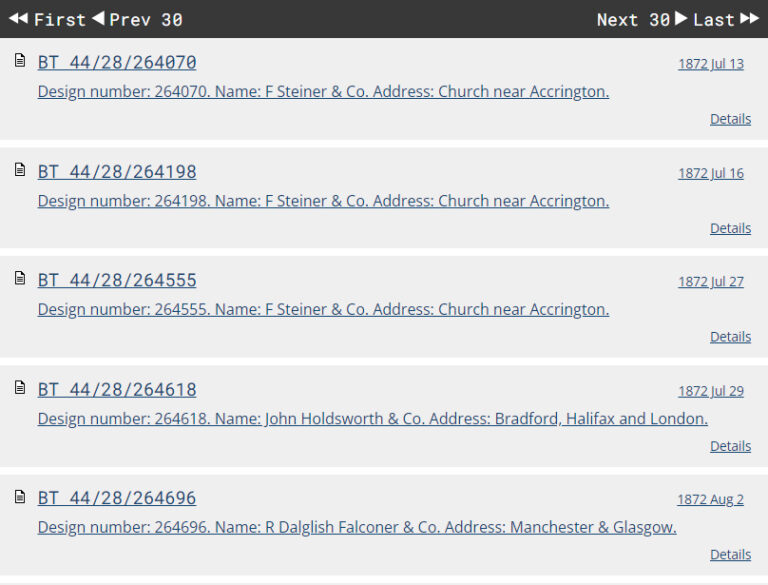
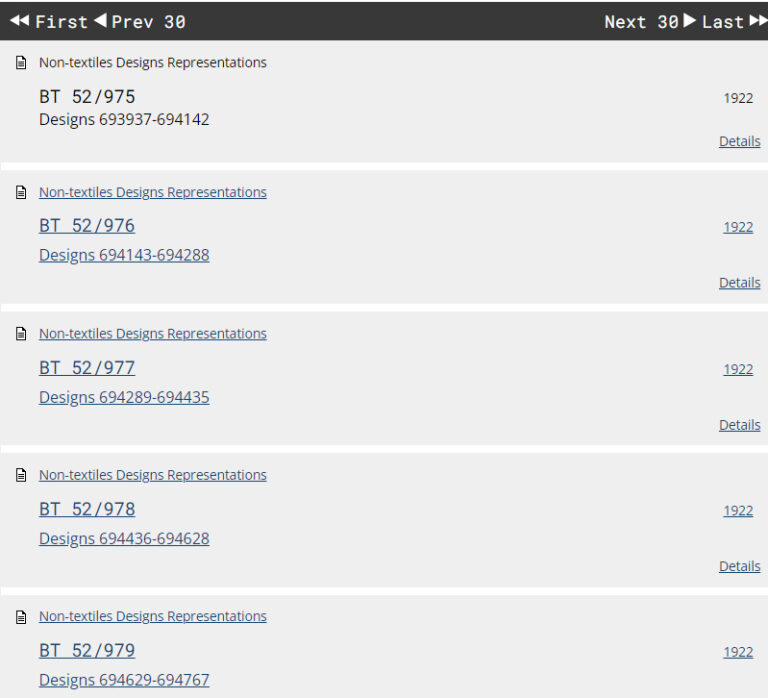
The Patents Journal
From 1884, details of newly registered designs and patents were published together each week in the Patents Journal – an official government publication. The Journal didn’t include information about textile designs as these were more closely guarded by their proprietors.
Copies of the original journal are held at the British Library. The library also has a set of bound volumes containing copies of the journal entries for just the registered designs (no patents) covering the years 1901 to 1932. These bound volumes were scanned into PDFs that could be read by a computer program using OCR (Optical Character Recognition).
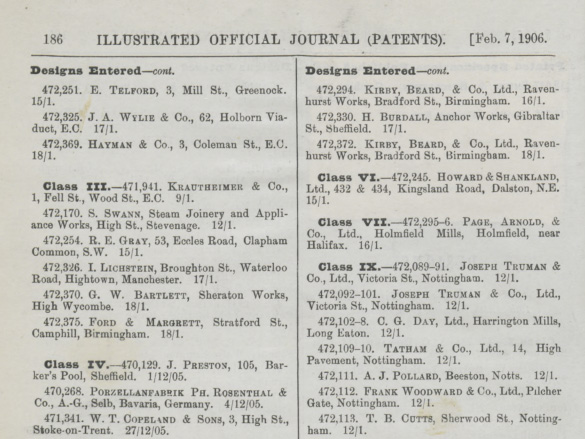
Using OCR, the information about the designs was taken from the PDF for each year and reproduced in a corresponding spreadsheet. It was separated into columns for material class, registered design number, name and address of the proprietor and the date the design registration was authorised.
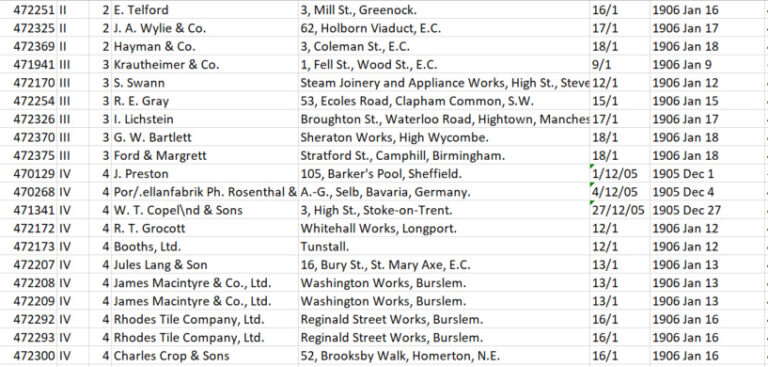
OCR inaccuracies
The OCR process is not perfect, and looking at the spreadsheets showed some frequently repeated errors. These could be addressed by writing code that effectively taught the computer to recognise and correct them.
The computer was also able to flag up certain types of entry that it knew might not be right but it couldn’t be trained to correct – for instance if there was a number in the name field, or an unusually long entry in an address field. These potential errors were listed in a ‘log file’ for each year.
Volunteers
Other errors were more sporadic and not as easy to correct with coding. So in April 2022 we began to recruit volunteers to work from home, checking and ‘cleaning’ (correcting) the data in the spreadsheets for specific years.
Volunteers were each sent four documents relating to a specific year:
- the PDF of the Patents Journal
- the spreadsheet of extracted information
- the log file
- a comprehensive guide to the checking process
The volunteers check the potential errors flagged up in the log files, and also check the spreadsheets by eye. They look for entries that don’t look right, checking the original information in the PDFs and correcting the spreadsheets accordingly.
Quantity of data
The quantity of the data from the Patents Journal tells a story in itself as it varies from year to year. In 1901 there were 9,083 designs listed, rising to 17,970 in 1909. The impact of the First World War can be seen when only 7,946 designs are listed in 1915 and 2,787 in 1918. After the war, the numbers stayed in the 5 and 6 thousands until the 1930s when they pushed up into the 7 thousands reaching 7,936 in 1932.
Over the 32 years from 1901 to 1932 a total of 282,510 designs were listed in the Patents Journal. Alongside these designs there were many thousands of textiles also being registered, but their details were not included in the journal.
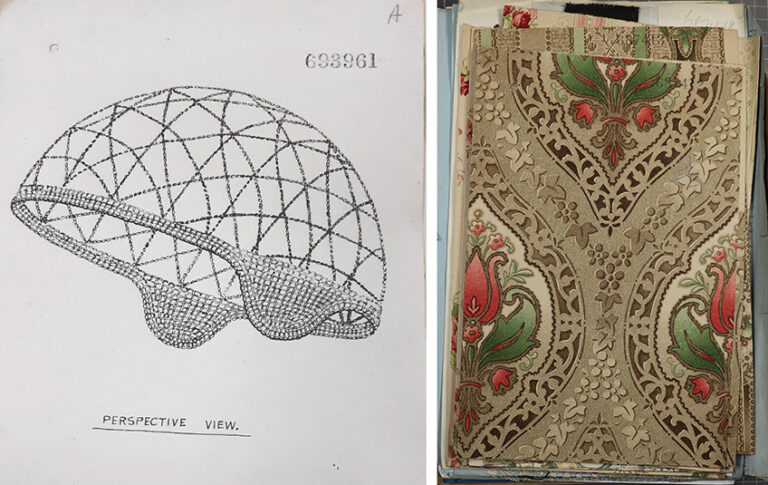
This project has been a step into the unknown, working with scanned data from a secondary source, rather than transcribing information from original documents. It has meant staff from different areas of The National Archives working together to find the best way to sort and correct the data, and it has so far involved more than 30 volunteers working remotely to look for and correct errors.
The target end date for the project is March 2023, by which time we hope to have added over 250,000 item level descriptions to the catalogue, opening up the potential for further research into design and social histories in the early part of the 20th century.
Footnote
The material class is a number allocated depending on the nature of material used – china, glass, metal, textile etc.